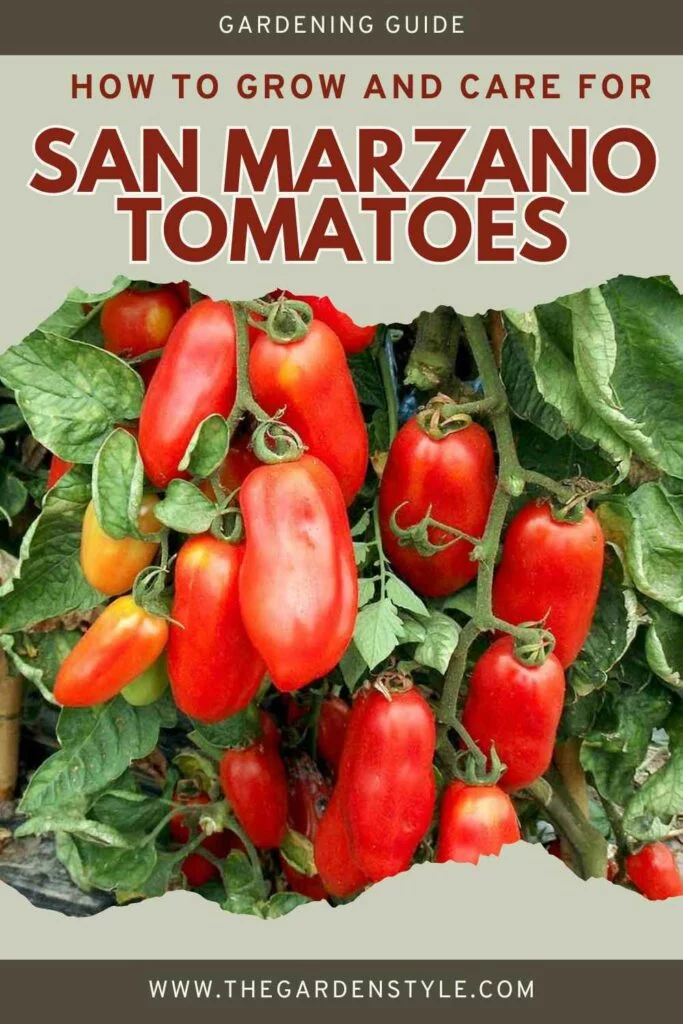There are many varieties of tomatoes in the world, although some are specific for fresh consumption, others for canning, and others for drying. The San Marzano tomato is a well-known type of tomato that is commonly used to make Italian sauces, particularly for pizza. Continue reading to know all about growing San Marzano tomato.
In this article, we want to tell you about the main characteristics and qualities offered by the San Marzano tomato variety, typical of the Italian region of Campania and highly valued for canning. You will also learn how to grow San Marzano tomatoes correctly to have an abundant harvest.
Table of Contents
Characteristics of San Marzano Tomato
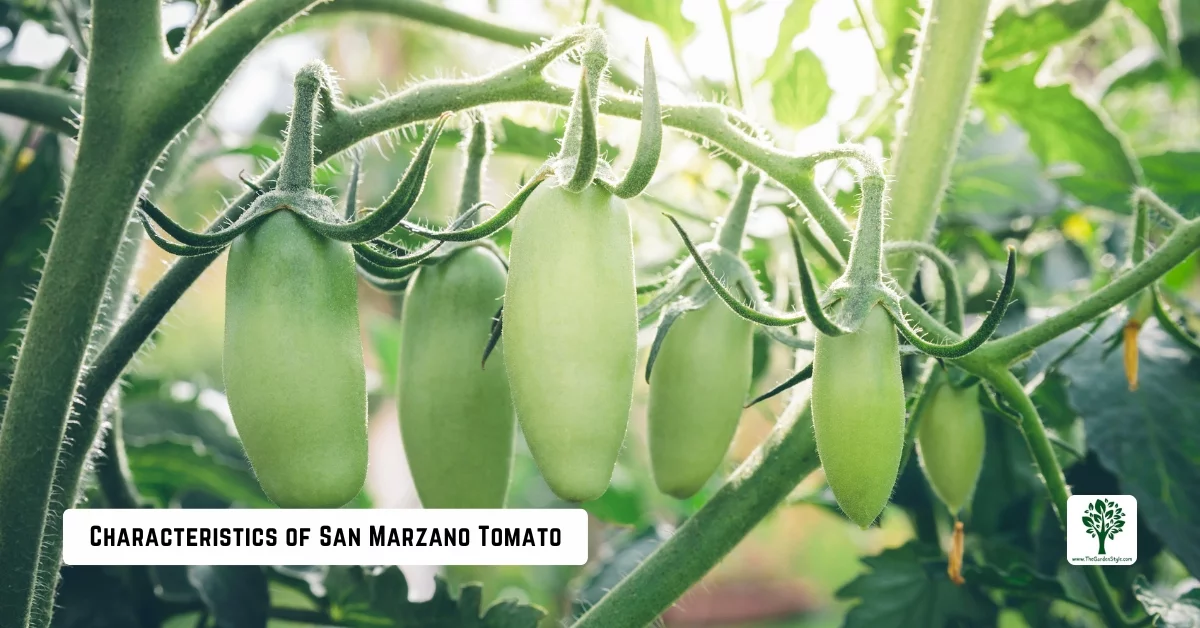
The best-known Italian tomato worldwide is the Roma tomato or also known as the Italian tomato. The traditional Neapolitan paste is made with the best tomato varieties, providing an extraordinary flavor and a perfect ratio between acidity and sugar.
The San Marzano tomato is a derivation of this type of tomato, special for canning and making sauces. It has been cultivated in different Italian areas since 1770 when its seeds were a gift from the Viceroyalty of Peru (the origin of many Solanaceae) to the Kingdom of Naples.
This variety of tomato has a medium size, although what characterizes it is its elongated shape, in the shape of a stretched pear, similar to that of a bell pepper, and that has nothing to do with the concept we have of a round tomato.
This type of variety, like many of the current hybrids that have been designed for industrial tomatoes, tends to have a disorderly and chaotic growth, with a lot of bunch and stem production.
However, in this case, the San Marzano tomato is not a creeping variety like the industrial tomato. It is usually grown in greenhouses or outdoors and needs stakes to maintain its verticality.
The San Marzano tomato plant is quite productive and can produce up to 10 fruits per bunch, which, in a long cycle, is a lot of pounds of production per square foot of surface area. Continue reading to learn about growing San Marzano tomato.
How To Grow San Marzano Tomatoes
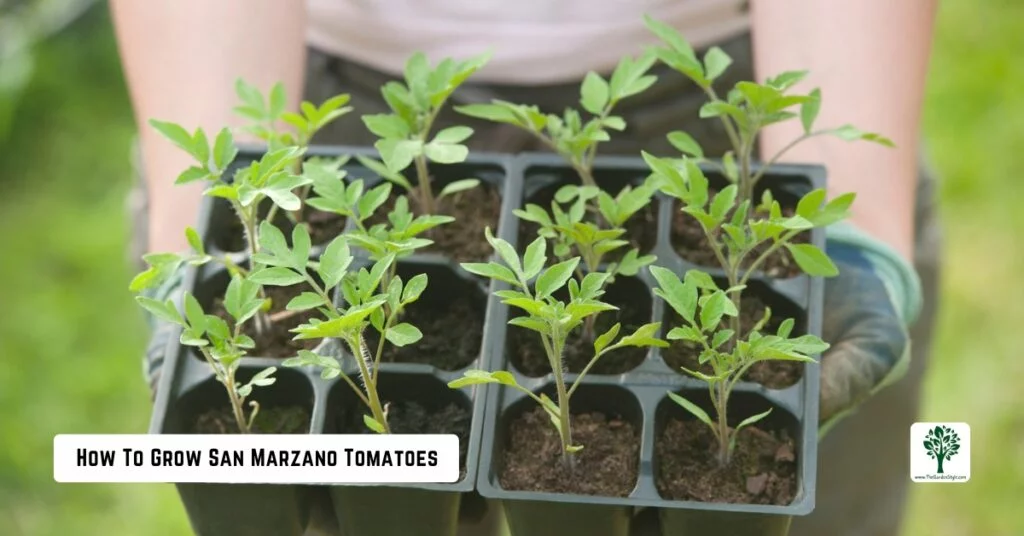
Growing San Marzano tomato is not difficult, but you must keep in mind that it is a process that takes time to obtain the first tomatoes. It is also essential to use stakes or trellis for the correct growth of San Marzano tomatoes and to obtain a good production.
Get quality San Marzano tomato seeds to ensure a high germination rate. You can sow the seeds in seedbeds indoors a few weeks before the last frost. Do not bury the seeds deeper than 1/4 inch (0.6 cm) and use a nutrient-rich substrate.
Sowing San Marzano tomato seeds in March (spring in the Northern Hemisphere) will allow you to harvest the tomatoes approximately in June. Of course, these times may vary depending on the weather conditions and nutrients the plant gets.
The ideal temperature for the growth of San Marzano tomato is from 68 °F to 86 °F (20 °C to 30 °C). Temperatures below 59 °F (15 °C), will have problems with growth and pollination. Above 95 °F (35 °C), pollination is affected, and pollen quality drops considerably.
San Marzano tomato plants should be located in a site that receives at least 6 to 8 hours of direct sunlight for proper plant and fruit development. The substrate should be rich in nutrients and have a pH between 6 and 7.5. Apply tomato fertilizer NPK 3-4-6 or similar the moment you observe the first flowers on the tomato plant. This will ensure that the tomato plant gets all the nutrients needed for fruit development.
Following all these steps and tips you will obtain an abundant harvest of San Marzano tomatoes to make exquisite sauces or delicious dishes. San Marzano tomatoes are my favorite for sauces and canning.
- Classic Flavor – San Marzano tomato is famous as the base for a complex and flavorful tomato sauce. It is used extensively in Italian cuisine.
Are San Marzano Tomatoes Hard to Grow?
It is not at all hard to grow San Marzano tomatoes. The most important thing to consider when growing San Marzano tomatoes is to use stakes and trellis to support the growth of the plant. By using a trellis or stakes the tomato plants will grow properly, and the fruits will be separated from the soil.
Finally, it is also essential that the location of the San Marzano tomato plants be in a place where they receive abundant sunlight for the correct development of the plants and fruits. I recommend at least 6 to 8 hours of direct sunlight for the correct development of tomato plants.
Hardening Off San Marzano Tomatoes
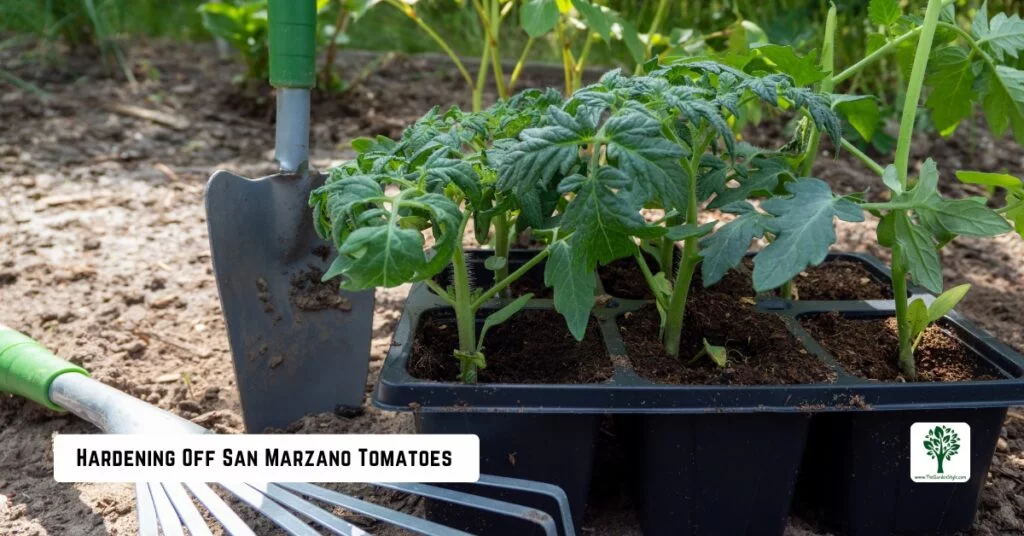
San Marzano tomatoes are warm weather crops that should only be transplanted outdoors after the last expected spring frost. However, it’s important not to move them directly from their indoor growing environment to full sun and wind exposure. This can shock the plants and stunt or damage their growth.
Instead, San Marzanos need to be “hardened off” through a gradual process that exposes them to outdoor conditions over the course of 7-10 days. This allows the plants to adjust to the lower humidity, wind, cooler nights and increased sunlight before being left out permanently.
Here are the steps for properly hardening off San Marzano tomato seedlings or transplants:
- On a warm, calm day, place the seedlings in a shady spot outdoors for 2-3 hours in the late afternoon. Bring them back inside for the evening.
- Over the next few days, gradually increase the time the plants spend outdoors to 4, 6, then 8 hours. Move them into spots with increasing sunlight exposure.
- After 4-5 days of this process, leave the plants outside overnight if temperatures stay above 50°F. Protect them if it’s colder than that.
- By day 7-10, the San Marzanos should be able to withstand full-day sun and outdoor conditions overnight. Plant them in their final spot in the garden.
Be sure to water seedlings well before placing them outdoors and check soil moisture frequently during hardening off. This process toughens the stems and leaves to prevent transplant shock. Hardened-off plants are established more quickly after transplanting.
San Marzano Tomato Companion Plants
Companion plants can offer numerous benefits to San Marzano tomatoes. Here are some examples:
| Companion Plants | Benefits for Tomatoes |
|---|---|
| Basil | Enhances flavor and repels pests |
| Thyme | Attracts beneficial insects and improves flavor |
| Parsley | Attracts predatory insects and improves flavor |
| Chives | Repels pests and improves flavor |
| Cilantro | Attracts beneficial insects and improves flavor |
| Marigolds | Repels nematodes and other pests |
| Petunias | Deters certain pests and adds color |
| Nasturtiums | Repels aphids and attracts predatory insects |
| Zinnias | Attracts pollinators and adds color |
| Calendula | Deters pests and promotes healthy growth |
| Carrots | Breaks up soil and provides ground cover |
| Peppers | Deter some pests and improve flavor |
| Asparagus | Acts as a natural pest deterrent |
| Radishes | Deter certain pests and improve soil structure |
| Cucumbers | Improve flavor and repel pests |
If you want to learn more about the top companion plants for tomatoes, I suggest checking out our article on Tomato Companion Plants for Beginners.
How to Care for San Marzano Tomatoes
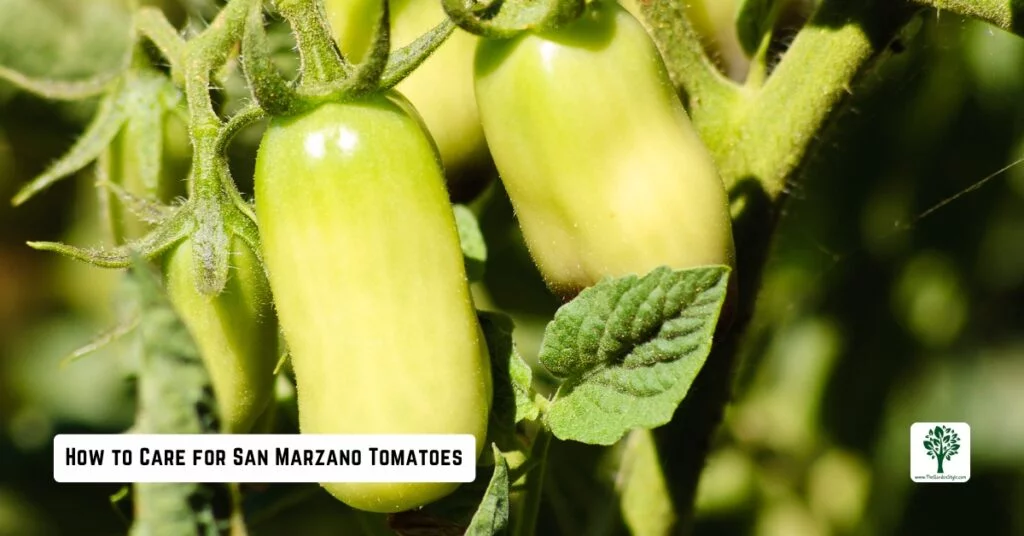
San Marzano tomatoes, known for their rich flavor and meaty texture, require proper care to thrive and produce bountiful harvests. Here are some essential tips for caring for your San Marzano tomato plants:
Planting: Choose a sunny location with well-drained soil for planting your San Marzano tomatoes. Ensure that the soil is rich in organic matter and has a pH level between 6.0 and 6.8, which is optimal for tomato growth.
Watering: Maintain consistent soil moisture with about 1-2 inches of water per week. Avoid getting the leaves wet when watering to prevent fungal diseases. Mulching around the plants helps retain moisture.
Mulching: Apply a layer of organic mulch, such as straw or shredded leaves, around the base of the San Marzano plants. Mulching helps retain soil moisture, suppresses weed growth, and regulates soil temperature, promoting healthier growth and fruit development. Learn about the best mulch for tomato plants.
Support: San Marzano tomato plants are indeterminate, meaning they continue to grow and produce fruit throughout the growing season. Provide sturdy support structures, such as tomato cages or stakes, to keep the plants upright and prevent them from sprawling on the ground. Prune the lower foliage regularly to improve air circulation and reduce the risk of disease.
Fertilizing: Feed your San Marzano tomatoes with a balanced fertilizer or organic compost to provide essential nutrients for vigorous growth and fruit production. Alternatively, consider using fish fertilizer, which is rich in nutrients like nitrogen, phosphorus, and potassium, promoting healthy foliage and robust fruiting. Start fertilizing when the plants begin to flower and continue every few weeks throughout the growing season.
How Many Tomatoes Does a San Marzano Plant Produce
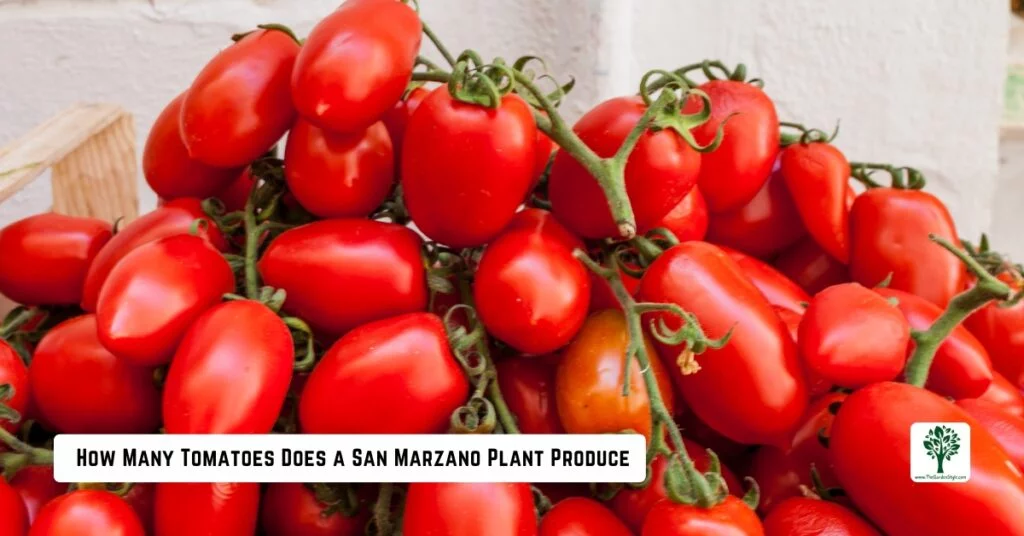
San Marzano tomato plants produce a lot of fruit. A single San Marzano tomato plant can provide up to 100 tomatoes during its production cycle. In addition, if you grow San Marzano tomatoes in a greenhouse, it is possible to extend the production cycle a little longer.
Not all tomatoes will be ripe at the same time. Never pull the tomatoes off the plant to avoid damaging the plant. I recommend reading our article on harvesting San Marzano tomatoes for information on harvesting.
Pests and Diseases of San Marzano Tomatoes
San Marzano tomatoes are not usually affected by many pests. Should pests such as aphids appear, they can be controlled using ladybugs or neem oil. However, it is important to watch for blossom end rot, a disease caused by a lack of calcium in the fruit. To prevent this rot, crushed eggshells or lime can be added to the soil. I recommend you read our article on how to use neem oil on tomato plants.
Final Conclusions
The San Marzano tomato crop is one of the favorites that I have every year in the garden because it gives me fruits in abundance to prepare my favorite sauces for pizzas and plates of pasta. I hope this article on growing San Marzano tomato will greatly help you and that you will have excellent tomato plants.
If this post about growing San Marzano tomato was helpful, please share it:
